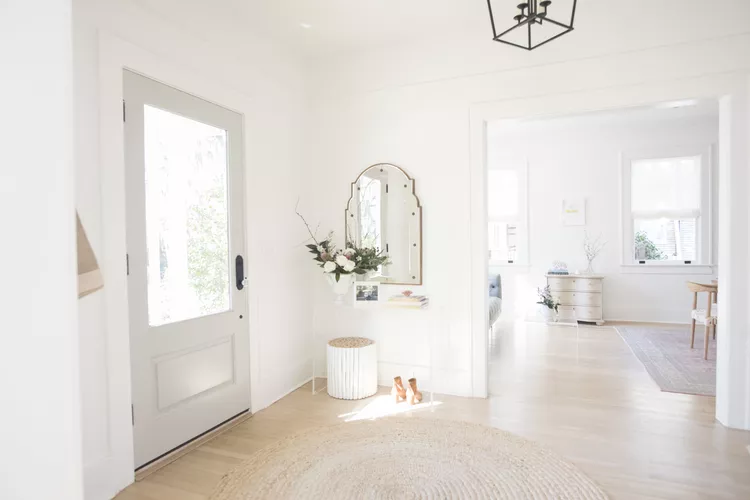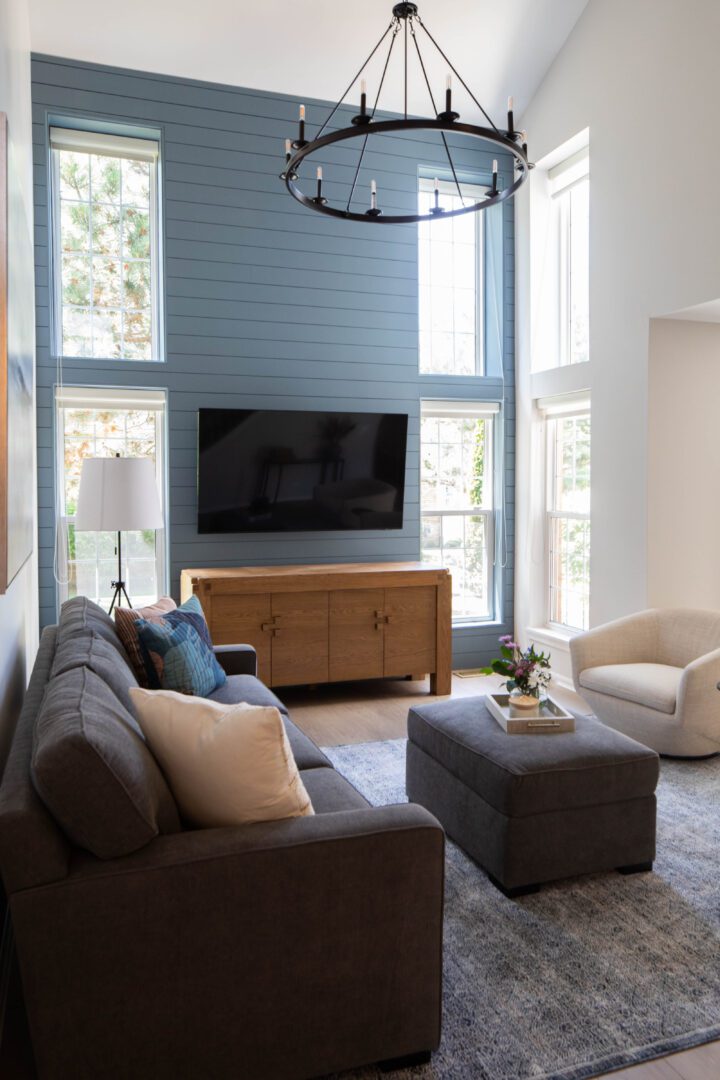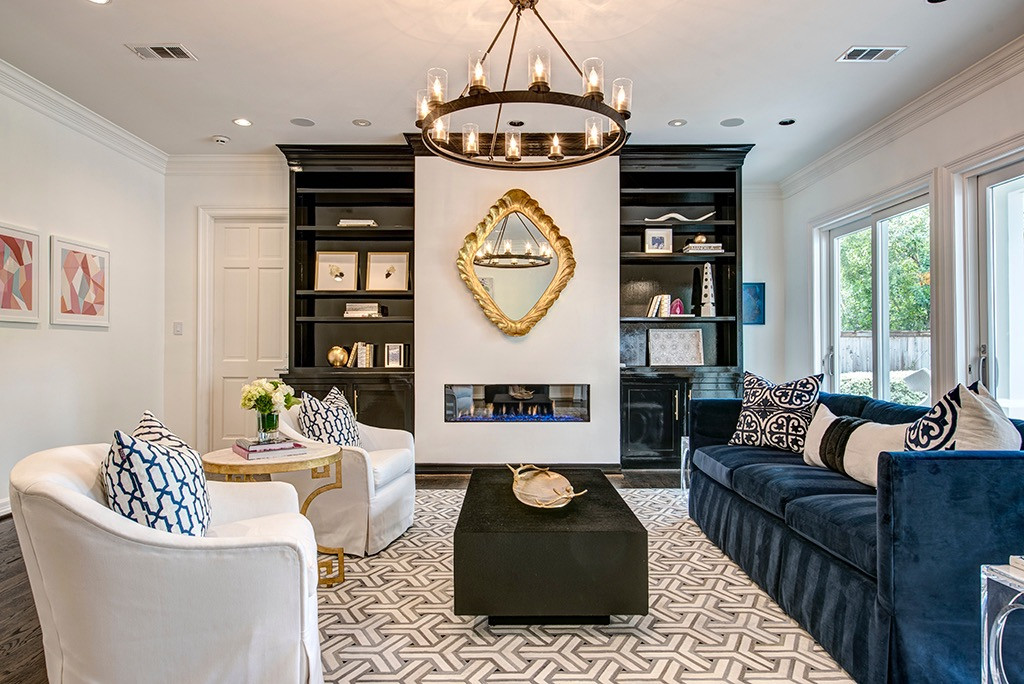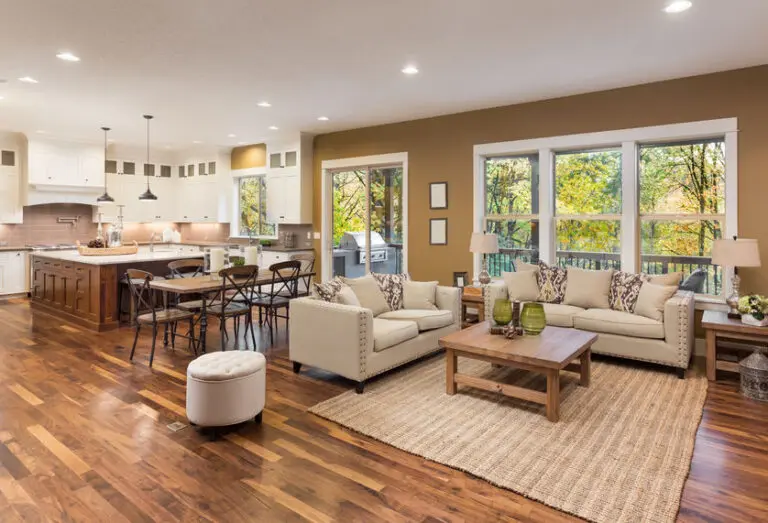When a front door opens directly into a living room, it presents unique decorating challenges and opportunities. The entryway to any home sets the tone for the entire living space, making it crucial to design a welcoming and functional area. For homes without a separate foyer, the living room becomes the first point of contact for guests, combining the roles of receiving space and main communal area.

Effective decor in such a space requires a thoughtful balance between aesthetics and practicality. Furniture placement becomes a key consideration to ensure a seamless transition from the outdoors to the indoor living area. Strategic use of rugs, lighting, and seating can delineate the space, guiding traffic flow and creating an inviting atmosphere.
Incorporating cohesive design elements can unify the living room and entryway. This approach helps to maintain an open feel while establishing a distinct area that serves as an introduction to the home’s interior. By considering scale, color schemes, and stylistic details, homeowners can achieve a harmonious living room that gracefully welcomes residents and visitors alike.
Design Principles for Front Entryways

Source: The Spruce
When a front door opens directly into the living room, careful design consideration is essential. The goal is to create a welcoming space that offers a smooth transition while maintaining the living room’s style and function.
Zone Creation: They can establish a distinct area using furniture or rugs to create an “entryway” within the living room. This delineation ensures visitors aren’t immediately immersed in the private living space.
Lighting: Adequate lighting is crucial. They might consider a statement light fixture that complements the living room decor while clearly defining the entry space.
Color and Texture: They should use color and texture to their advantage. A consistent color palette can tie the entryway to the living room, while varying textures can designate the spaces without physical barriers.
Storage Solutions: Clutter is an unwelcome guest. They can incorporate streamlined storage solutions like slim console tables, wall hooks, or benches with hidden storage to keep the area organized and inviting.
Mirrors and Artwork: Mirrors can make the space feel larger and brighter. Strategic placement of artwork can draw the eye and signify the transition from outdoor to indoor space.
Furniture Placement: Furniture should be arranged to guide traffic flow away from the immediate living area. This prevents obstruction and promotes a sense of openness.
| Design Element | Strategy |
|---|---|
| Zone | Furniture arrangement or area rugs |
| Lighting | Statement fixtures |
| Color/Texture | Cohesive palette, varied tactile surfaces |
| Storage | Multi-functional furniture, wall solutions |
| Decor | Mirrors to expand, artwork to engage |
| Furniture | Positioned to direct movement |
Such principles ensure the front door opening into a living room becomes an intentional design feature, not a hindrance.
Maximizing Small Spaces
When a front door opens directly into a living room, strategic decor enhances the area’s functionality without sacrificing style. Furniture selection and placement are pivotal. A slim console table behind the couch acts as a subtle divide and provides a surface for key-drop or mail. The table should be proportional to the sofa and hallway, ensuring an unobstructed pathway.
Multifunctional furniture is a wise investment. Pieces like ottomans with storage double as seating and hideaway spots for household items. Similarly, a daybed can serve as comfortable seating during the day and a sleeping area for guests at night.
Mirrors are a decorator’s ally in small spaces. A large mirror not only reflects light but creates the illusion of depth. It should be placed opposite a window to maximize natural light and visually expand the room.
For organization, floating shelves and wall-mounted racks utilize vertical space and free up the floor. They should be spaced evenly and not overcrowded to maintain a neat, open feel.
The color palette influences spatial perception. Light colors make rooms appear larger and airier. When choosing paint or wallpaper, one should prefer pastel shades or neutrals. To add depth, a single darker accent wall can be employed, optimally the one farthest from the entrance.
Lastly, consider the flow of movement. Keep paths clear by arranging furniture to direct traffic around conversation areas, not through them. This guidance ensures the living room feels welcoming and uncluttered.
| Furniture Type | Function | Placement Tips |
|---|---|---|
| Console Table | Divides space, holds items | Behind sofa, align with hallway |
| Ottoman | Additional storage and seating | Central, as coffee table or side piece |
| Daybed | Seating and guest bed | Against a wall, with decorative pillows |
| Mirror | Reflects light, adds depth | Opposite a window, at eye level |
| Shelves / Racks | Storage without footprint | Above furniture, spaced evenly |
Furniture Selection for Living Rooms with Entrance Doors
When selecting furniture for living rooms that open directly into the entrance, several factors should be considered to ensure the space is welcoming, functional, and stylish. The goal is to create a seamless transition from the outdoors to the indoor living space while maintaining a sense of order and beauty.
First Impressions:
A console table placed behind the couch can serve as a transitional piece, offering both a warm welcome and a practical surface for keys and mail. Opt for slim designs that don’t overcrowd the space.
Seating Arrangements:
Utilize multi-functional seating like ottomans that can double as storage. This keeps the area clutter-free. Position chairs and couches in a way that defines the living room without blocking the entryway.
- Sofas should face the inner room to emphasize the living area.
- Armchairs can be angled towards both the living space and the entrance, acting as a linkage.
Rug Placement:
An area rug can delineate the living room space, establishing boundaries non-verbally.
- Ensure the rug is large enough to include all seating elements, creating a cohesive zone.
Lighting Selection:
Choose lighting that complements both the entrance and living room. Wall sconces or a statement chandelier can serve dual purposes, illuminating the space and acting as decorative elements.
Smart Storage:
Incorporate shelves or cabinets for shoes and outerwear disguised as living room furniture. They should be accessible yet blend seamlessly with the room’s décor.
| Furniture Piece | Purpose | Placement |
|---|---|---|
| Console Table | Welcome, Storage | Behind couch, near doorway |
| Ottoman | Seating, Storage | Within seating arrangement |
| Area Rug | Define Space | Under furniture, central |
| Wall Sconces | Lighting, Decor | Flanking entrance |
In summary, choose furniture that is versatile and proportionate to the space, ensuring the entrance flows naturally into the living area.
Color Schemes and Lighting
Source: The Spruce
When one’s front door opens directly into the living room, the choice of color schemes can significantly influence the ambiance. Lighter hues are often recommended, as they make spaces seem larger and more inviting. Neutral colors like beige, soft gray, and creamy white are timeless and flexible, allowing for easy decor updates. They should be complemented by accent colors that can be introduced through accessories such as pillows, rugs, and art.
For instance, a palette may include:
- Base Color: Creamy white
- Accent Color 1: Navy blue
- Accent Color 2: Mustard yellow
Lighting plays a pivotal role in the perception of space. A well-lit room feels warm and welcoming. Natural lighting should be maximized with sheer window treatments. In the evening, ambient lighting can be achieved with the strategic placement of lamps and ceiling lights.
Key lighting elements:
- Overhead Lighting: A statement chandelier or flush mount
- Task Lighting: Floor lamps or reading lamps next to seating
- Accent Lighting: Wall sconces or picture lights to highlight artwork
The interplay between color and light must be harmonious, with lighting fixtures selected to complement the color scheme rather than overpower it. Effective lighting should create a serene atmosphere that feels both cohesive and balanced upon entry.
Decor Accents and Focal Points
Source: houzz
When a front door opens directly into a living room, creating a welcoming atmosphere while delineating the space is crucial. Accent pieces such as a striking area rug or a distinctive piece of art can draw the eye and establish a focal point away from the entrance.
- Area Rugs: An area rug with a vibrant pattern can anchor the living room and add warmth.
- Art Pieces: A bold painting or a sculpture can serve as a conversation starter and a visual anchor.
- Light Fixtures: Statement lighting, like a chandelier or a unique floor lamp, provides both function and style.
It’s useful to incorporate elements that balance the space:
- Mirrors: Strategically placed, they can make the space appear larger and more open.
- Plants: Greenery can soften the transition from the outdoors and add life to the decor.
Using furniture placement to define areas creates a sense of organization:
- Console Table: Positioned behind a sofa, it can act as a barrier that subtly separates the entryway from the living space.
- Accent Chairs: Placed in a conversational layout, they invite guests to sit and relax.
Color Palettes and Textures play a significant role in unifying the space:
- Soft, neutral colors can make the room feel more expansive.
- Textured throws and cushions add depth and interest.
In conclusion, the living room can be both functional and stylish, with thoughtful placement of decor accents and establishment of clear focal points.
Flooring Options for Cohesive Flow
Source: Carpet Closeouts
When selecting floors for a living room with a front door opening directly into it, continuity is key. They should choose materials that offer a seamless transition, ensuring a visually larger and more welcoming space.
Hardwood floors offer enduring appeal. Their natural tones and textures suit various decor styles, creating a smooth visual flow. Notably, hardwood is also adept at handling high foot traffic areas.
Laminate flooring is a cost-effective alternative, mimicking hardwood’s aesthetic. Opting for wide planks minimizes seams and enhances spatial continuity.
Flooring Features to Consider:
- Color: Neutral colors blend spaces effortlessly.
- Texture: Consistent texture unifies the area.
- Pattern: Simple patterns prevent visual clutter.
Pros and Cons:
| Flooring Type | Pros | Cons |
|---|---|---|
| Hardwood | Durable; Timeless Appearance | Higher Cost; Maintenance |
| Laminate | Affordable; Easy Installation | Less Durable; Prone to Water Damage |
For small spaces, they may consider lighter floor shades to make the room appear larger. Meanwhile, area rugs can define seating areas without disrupting flow. They should avoid abrupt transitions, and instead, favor complementary or matching flooring materials from the front door through to the rest of the home.
Creating Functional Areas
Source: BOMONTİ
When a front door opens directly into the living room, defining separate functional areas becomes crucial. Zoning is the key strategy, which involves dividing space based on activities without building walls.
- Entryway Zone: Use a bold console table or bench to signal the transition from outside to inside. This also offers a surface for keys and mail, and a place for guests to sit and remove shoes. An area rug can further demarcate this space, and a row of hooks or a coat stand provides a practical touch for hanging attire.
- Seating Area: Define the main living space with a larger area rug anchoring a sofa and chairs. Keeping furniture facing inward promotes conversation and a cozy atmosphere.
- Visual Dividers: Bookcases, plants, or a room screen can create a soft division between zones without obstructing the view or light. They’re movable, adding flexibility to the layout.
- Lighting: Different types of lighting can indicate different areas. A bright overhead light for the entry, floor lamps for the seating area, and perhaps accent lights highlighting decor can all subconsciously guide the understanding of designated areas.
In apartments or homes where square footage is at a premium, multifunctional furniture, such as ottomans with storage, can be both decorative and practical. Shelves with decorative elements serve a dual purpose for storage and aesthetic appeal. The living room can maintain its welcoming ambiance while being organized into functional zones that cater to both the needs of occupants and guests.
Maintaining Privacy and Tranquility
When a front door opens directly into a living room, privacy can be a concern. Strategic placement of furniture and fixtures is crucial. A tall console table placed perpendicular to the door creates a visual barrier. Adding a decorative screen or room divider offers both privacy and an aesthetic touch.
For tranquility, the color palette plays a critical role. Soothing hues such as soft blues, greens, and earth tones help to create a calm atmosphere. Incorporating plants can also enhance the sense of peace and provide a natural barrier to the outside world.
Lighting should be soft and diffused to maintain a tranquil environment. Sheer curtains allow for natural light while maintaining privacy. For evenings, wall sconces and floor lamps with warm bulbs contribute to a serene ambiance.
One must also consider acoustic privacy. Thick rugs and drapes can absorb sound, reducing the noise from outside. Furniture with soft upholstery helps to dampen sound, further enhancing the tranquility of the space.
To summarize:
- Furniture: A console table or room divider for visual privacy.
- Colors: Soothing color palette for a relaxing atmosphere.
- Plants: Adding greenery for natural separation.
- Lighting: Soft lighting to promote calmness.
- Acoustics: Rugs and drapes to mitigate external noise.
Attention to these details ensures that the front door’s entrance into a living room doesn’t compromise privacy or tranquility.
Seasonal Decorations and Adaptability
When one’s front door opens directly into their living room, it affords homeowners the unique opportunity to make striking first impressions with seasonal decorations. The key to maintaining a fresh and inviting space is adaptability. Decor should be versatile enough to change with the seasons while still complementing the overall design of the living room.
Spring and Summer: These seasons are reminiscent of growth and vibrancy. Homeowners can incorporate floral arrangements or pastel-colored throw pillows to mirror the blossoming outdoors. A simple vase of fresh flowers or a lightweight, brightly colored throw can quickly transform the space.
| Season | Suggested Decor Items |
|---|---|
| Spring | Fresh flowers, pastel throws, light curtains |
| Summer | Marine accents, linen cushions, sheer fabric |
Fall: As the leaves change, so can the living room. Subtle introductions of orange, yellow, and deep red through items such as decorative pumpkins, autumn leaf garlands, or comforting throws can reflect the seasonal shift outside.
Winter: The chill of winter invites warmer textures. A living room can be adapted with soft blankets, plush rugs, and candles to add warmth. Elements like pinecones, winter wreaths, or soft lighting can create a cozy atmosphere, inviting guests to relax as soon as they step in from the cold.
By selecting items that are easy to interchange, storage is simplified, and one can maintain a clean and inviting entryway living room throughout the year. Embrace transient motifs and textures—this ensures the living room remains both stylish and functional, whatever the season.
Final Touches and Details
When decorating a living room with a front door opening directly into it, attention to final touches can define the space’s functionality and aesthetic. Thoughtful selection of accessories can create a welcoming atmosphere for both residents and guests.
- Area Rugs: A well-placed area rug can delineate the entryway, offering a warm welcome and protecting the flooring. Choose a durable, easy-to-clean rug that complements the living room’s color scheme.
- Lighting: Soft lighting creates an inviting ambience. Consider table lamps or a floor lamp near the seating area, and possibly a decorative ceiling fixture to brighten the entire room.
- Mirrors: A strategically placed mirror can enhance natural light, add depth, and serve as a last-minute checkpoint before leaving the house.
To maintain organization, incorporate storage solutions such as a slim console table or wall hooks. These can provide a quick spot to place keys and mail or hang coats and bags without encroaching on the living room’s primary function.
Plants and Artwork: Indoor plants can bring life and color into the space, while carefully curated artwork and photos on the walls personalize the room. Consider floating shelves to display cherished items without compromising floor space.
In summary, one should focus on harmony between form and function. Each final touch should not only elevate the design but also answer the living room’s practical demands. This balance ensures the space is both beautiful and livable.






